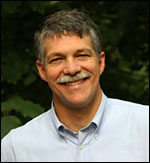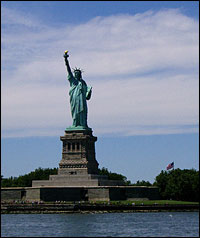Every year, millions of Americans pack up their families and head out to visit one of America’s national parks. My family was no different: I vividly recall the patchwork of reds, oranges, and yellows blanketing the Appalachian mountains as autumn made its big entrance one year. Another time, I remember being transfixed by a herd of Yellowstone bison — burly, ancient-looking creatures — crossing the paved road we were traversing in our large, modern minivan.
Maybe for you, the Statue of Liberty is an inspiration, the Mojave the place where you found yourself, the Alamo a sight you’ll never forget. That’s the “glory of the [national] park system,” says Tom Kiernan, president of the National Parks Conservation Association. “The system has a whole spectrum of stories about America and about each one of us as individuals.”

Tom Kiernan.
For almost a decade, Kiernan has led the NPCA — an independent, nonpartisan organization with more than 325,000 members — in its efforts to protect the 391 parks, monuments, and other sites run by the National Park Service. The group’s advocacy and education work has long focused on threats like acid rain, air pollution, park funding, and development. Now it’s turning to the one thing that could overshadow all of those concerns: climate change.
With an eye to the National Park Service’s upcoming centennial in 2016, NPCA recently released an action plan for fixing our park system and, just last week, a comprehensive report [PDF] on how climate change will affect the diversity of America’s parks.
Kiernan spoke to me from his office in Washington, D.C., about his hopes for these projects — and his hopes for the future of the lands he lobbies for every day.
So, first, what is your favorite park?
Ooh, goodness. Can I slightly dodge the question by giving you a couple of favorites?
Sure, sure, yes. I figured everyone asks you this …
You know, they do, and I’ve got a number of responses, none of which I’m terribly happy with. … Let me just give you two ends of the spectrum. I’ve spent a fair amount of time up in Gates of the Arctic National Park, north of the Arctic Circle up in Alaska. That’s deeply meaningful to me, as is the Vietnam Memorial, because my father’s name is up there. So you’ve got, for me at least, the park system as a whole spectrum of stories about America and about each of us as individuals that are really meaningful. You know, some of the parks tell my story, but a different set of parks tells your story. It might be based on where you might have gone as a kid, or maybe your great-grandfather was in the Civil War, and his story is told at Gettysburg.
[You’ve just published] an assessment of how global warming is affecting national parks [PDF]. Tell me about that project.
Like many others over the last couple of years, we have seen, observed, and gotten profoundly concerned with the impact of climate change on national parks.
The report says a number of things: First of all, it looks at the impact of global warming on different types of parks throughout the national park system and throughout the United States. So we are showing that global climate change will impact the full diversity of the national park system — a system representing the breadth of the natural and cultural treasures of this country.
We then go into some of the strategies, both from an individual American’s perspective — what we as individuals can do — and also what we as a country can do and need to do, both to reduce the impact of climate change in the parks and to help adapt and manage the national park system within what will be a warmer climate.
We’re trying to look at it from all those angles. We do see this as a clarion cry for our national park system and the need to address climate change, because it will profoundly harm the national park system if it continues unchecked.
What are you hoping to accomplish with the report?
First and foremost, it’s an education. [We want to] make sure people understand and become more deeply aware that our national parks are threatened, whether it’s Yellowstone, Denali, or the Statue of Liberty. We hope people will become more aware and … be motivated to take action — whether that’s personal action or whether it’s getting their assistance in encouraging Congress to take political action. Frankly, we are hoping people will become emotionally energized.
We feel strongly that Congress needs to move on climate change and that it needs to move at the same time on the other pollutants that are devastating our national park systems. So we are looking for a bill that addresses carbon, sulfur, nitrogen, and mercury. All four of those pollutants need to be addressed in a comprehensive way if we are going to protect the air quality of national parks.
How would you describe the current political climate as it relates to the parks?
We’re at a moment where the administration and Congress are becoming much more deeply aware of the needs of the national park system and are beginning to take action, so I’m at an early stage of getting optimistic.
We have, for example, the National Parks Centennial Initiative, which proposes the largest increase ever in the operating budget of the parks. The House of Representatives, under Norm Dicks’ (D-Wash.) leadership, actually exceeded what the administration put on the table. Under Sen. Dianne Feinstein (D-Calif.), the Senate committee essentially matched what the House did. So we’ve got some momentum around significant funding increases for the parks that are an important first step in addressing the broader funding challenges, and frankly, in addressing, then, some of these ecological and other challenges that the parks face.
How should we move toward some of the fixes you’ve suggested — and do you see momentum in that direction?
We do see some momentum in the Centennial Initiative, and the funding components of it are a strong initial step toward what [we’ve] called for … We do think we need additional funding increases in future years. We see that $258 million proposed increase by the administration as a strong first step, but far from sufficient to meeting the $800 million funding shortfall …
So [the parks] desperately do need additional funding, but we want at the same time to see significant management enhancements and greater efficiencies inside the park service. We also believe there are a number of other dimensions in preparing our parks for their second 100 years that need to get added to this total initiative between now and 2016 — things like expanding the national park system.
And back to air quality and climate change — you know, we cannot end up with a park system at the centennial that’s fully funded but yet is continuing to be hammered by horrendous air pollution. That’s not a park system that will survive its second 100 years.
Green is very trendy right now — you’ve got all these glitzy magazines doing entire issues on it — and there’s a lot of focus on climate change as opposed to a more traditional environmental focus on protecting land and endangered species. I’m wondering how you feel about that — has the increased attention benefited parks, or have you felt a move away from parks and lands and species?
I would describe what I see happening as a broadening of the environmental movement, an understanding in the environmental community that energy policy and climate change are extraordinarily important. But I don’t see it as a movement away from a more traditional focus on wildlife, habitat, endangered species, forestland and parks, or more land-based issues.
Here’s just one example that partially gets at this point: When you ask the American public which of the services provided by the federal government are the most appreciated, the No. 1 service — more than Homeland Security, more than Social Security, or Medicare, or Medicaid — is our national parks. People profoundly appreciate the national parks, as much as their local backyard fishing hole, or their local park, or their local national forest or wilderness area.
I see your point on the glitzy magazines and all that. Climate change and energy efficiency are broadening the movement, but not to the exclusion of the traditional love that we have for the outdoors and wildlife … I’m curious, is Grist doing well? You mention all the glitzy enviro magazines — are you guys doing well, too?
Yes, we’re definitely enjoying this. I hope it’s not a trend. I hope it’s just the start of something.
And you know what? I couldn’t agree more with that. You look at the dramatic investment from the venture capital community in environment and ecological systems, and that tells me this is not a fad. This is a fundamental shift in the way we live, in the way our economy is going to work, and it’s going to take at least a decade, if not longer, for that shift — for us to really see or feel a shift.
There are some tectonic shifts at work here with the environment, and open space, and natural ecosystems. People are starting to understand how profoundly important they are and how reliant we are on them. So I’m convinced that it’s so much more than a fad.



